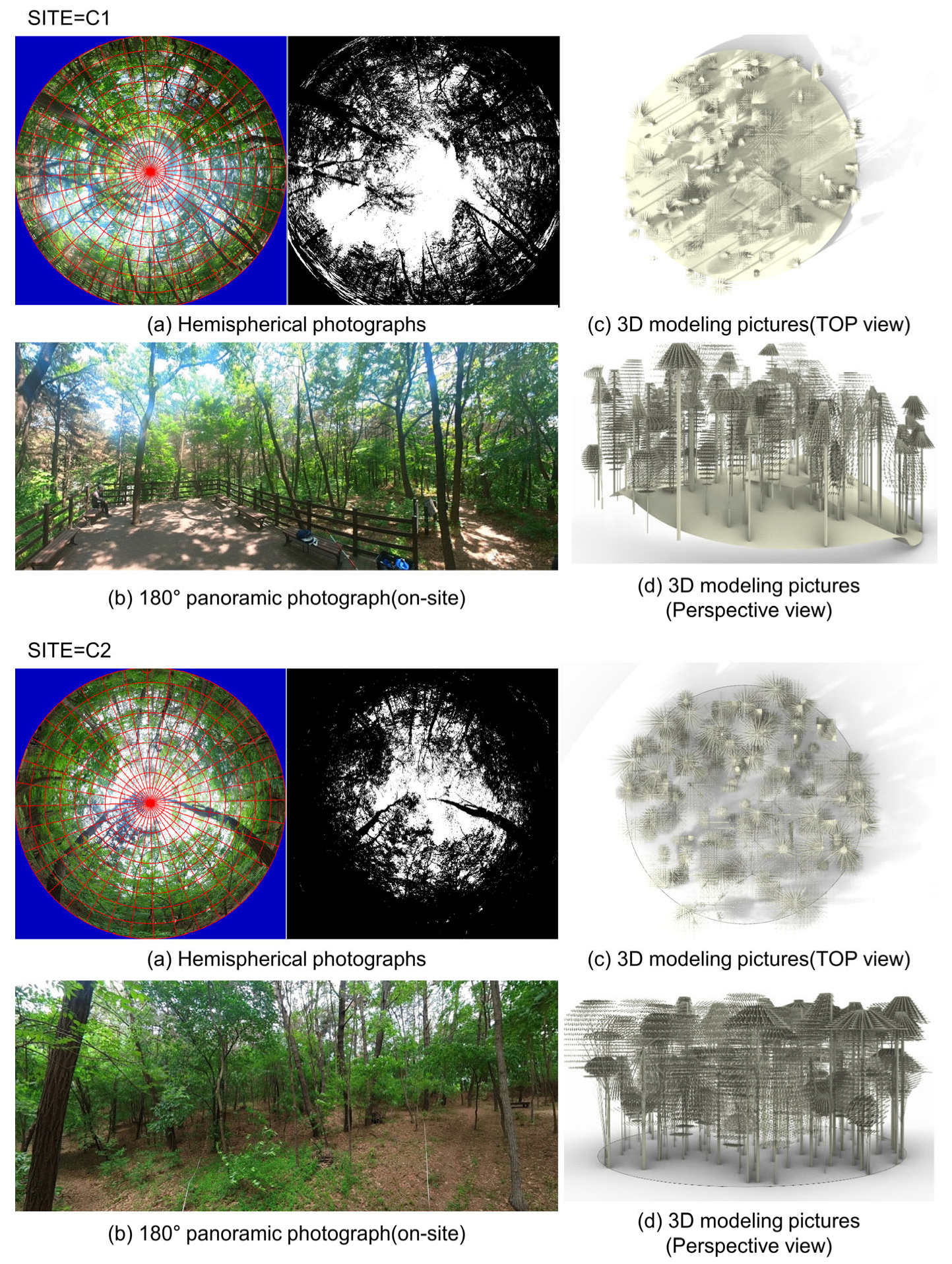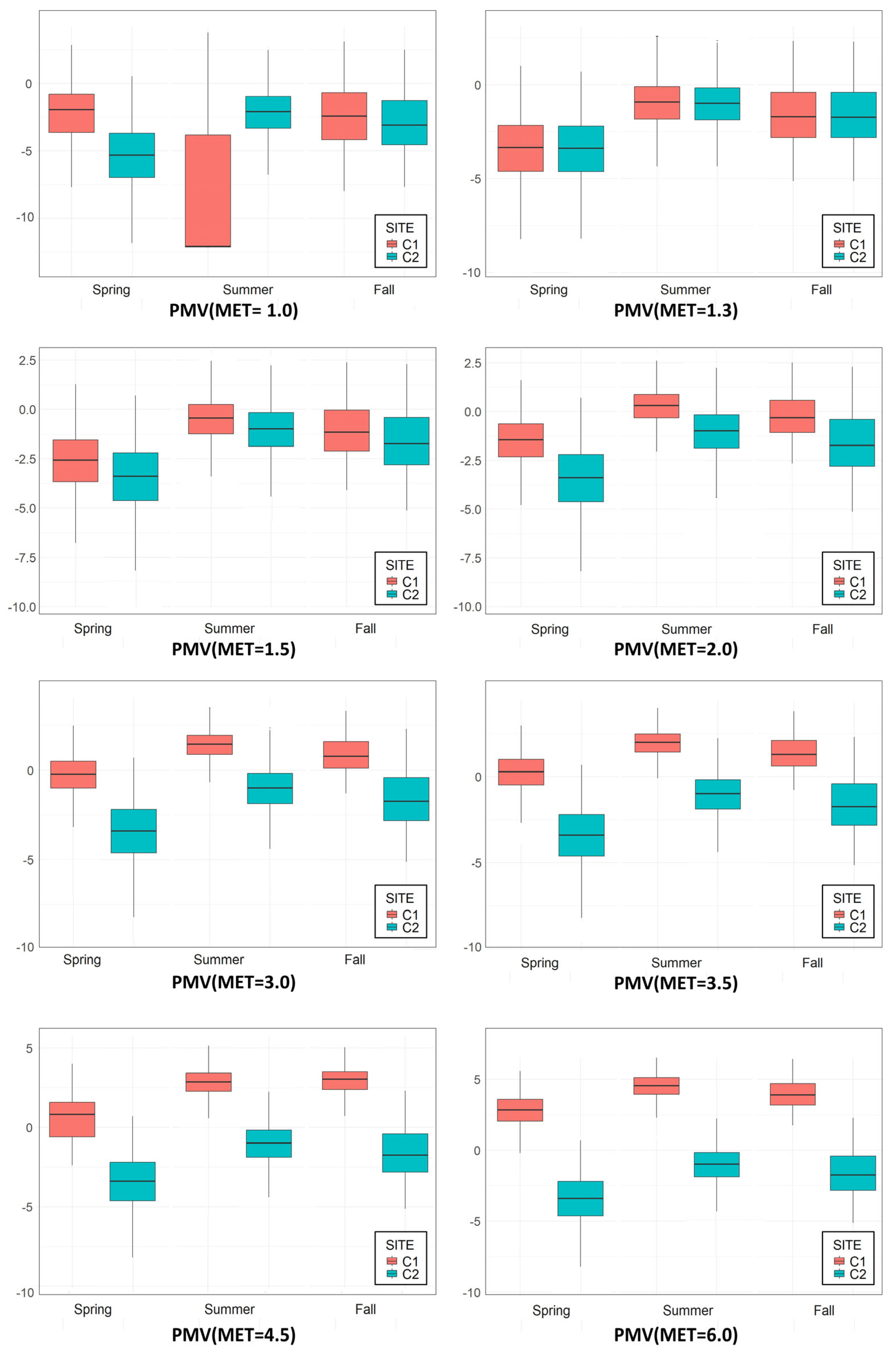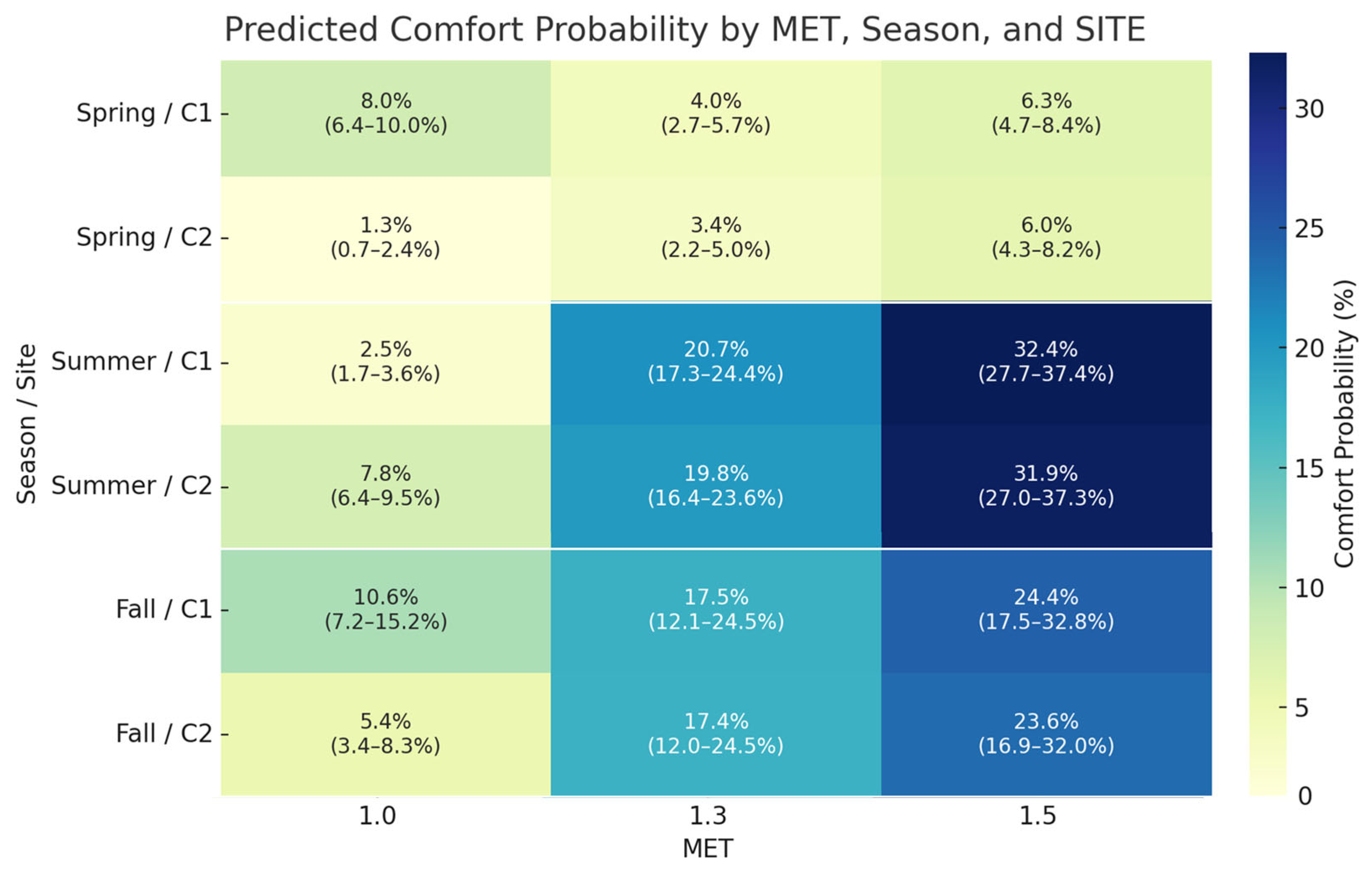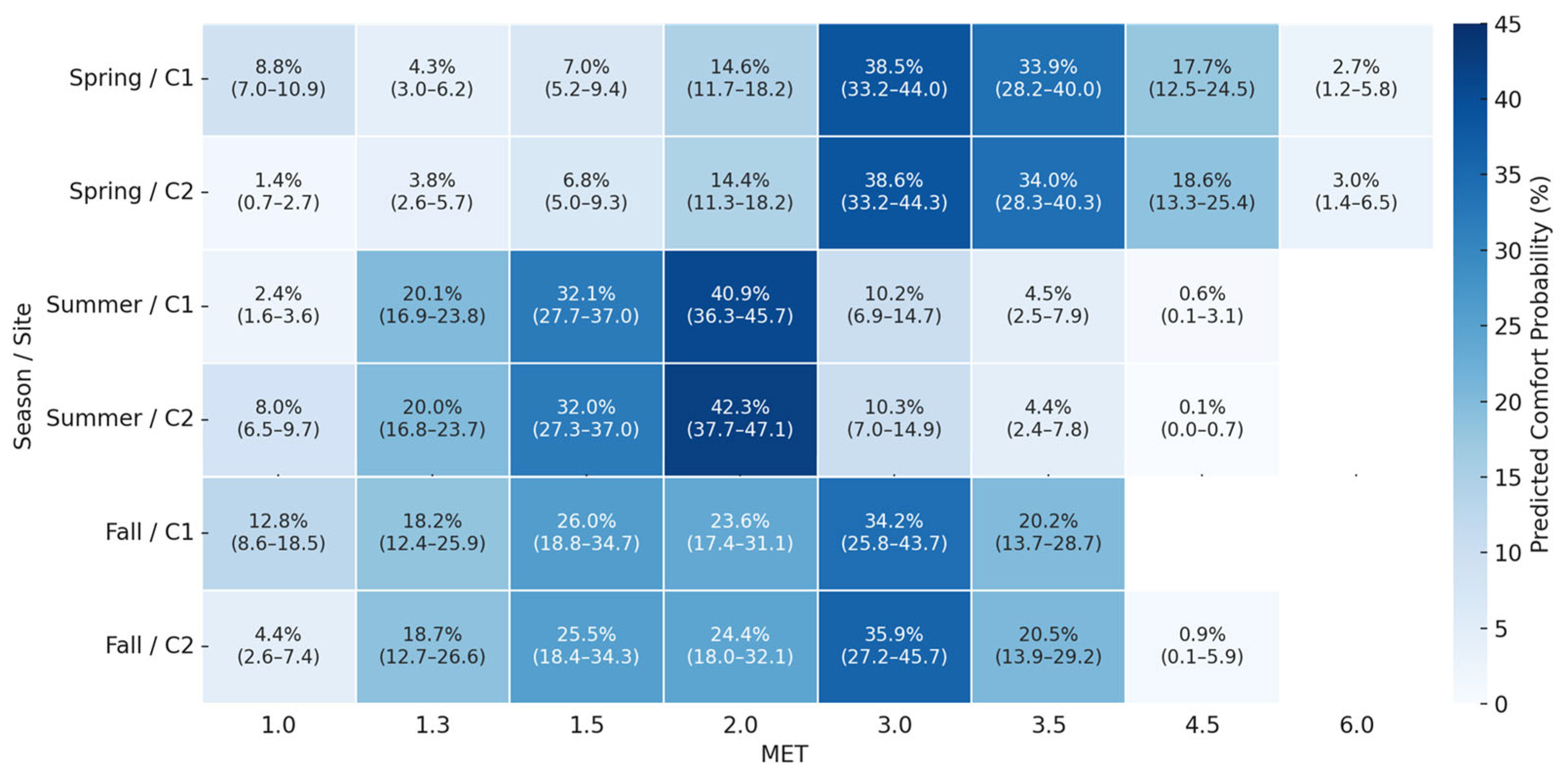Optimizing Season-Specific MET for Thermal Comfort Under Open and Closed Urban Forest Canopies
Abstract
1. Introduction
1.1. Motivation and Objectives
1.2. Related Work
2. Materials and Methods
2.1. Study Sites and Forest Environment Modeling
2.2. Thermal Environment Simulation
2.3. Thermal Comfort and Statistical Analyses
2.3.1. Comparative Analysis of Seasonal Mean PMV and Effect Sizes
2.3.2. Modeling Interactive Effects of Season, Site, and MET on Comfort (MET 1.0–1.5)
2.3.3. Estimating Season-Specific Optimal MET Levels Using GEE (MET 1.0–6.0)
3. Results
3.1. Thermal Comfort Comparison
3.2. Interaction Effects of Season, Site, and MET
3.3. Optimal MET Selection by Season
4. Discussion
5. Conclusions
Supplementary Materials
Author Contributions
Funding
Data Availability Statement
Conflicts of Interest
Abbreviations
| MET | metabolic equivalent of task |
| PMV | Predicted Mean Vote |
| MRT | mean radiant temperature |
| UHI | urban heat island |
| GEE | generalized estimating equation |
| QIC | quasi-likelihood under the independence model criterion |
References
- Ponraj, M.; Lee, Y.Y.; Din, M.F.M.; Noor, Z.Z.; Iwao, K.; Chelliapan, S. Overview of Urban Heat Island (UHI) Phenomenon Towards Human Thermal Comfort. Environ. Eng. Manag. J. 2017, 1, 2097. [Google Scholar] [CrossRef]
- Harlan, S.L.; Brazel, A.J.; Prashad, L.; Stefanov, W.L.; Larsen, L. Neighborhood microclimates and vulnerability to heat stress. Soc. Sci. Med. 2006, 1, 2847. [Google Scholar] [CrossRef]
- Heaviside, C.; Macintyre, H.L.; Vardoulakis, S. The Urban Heat Island: Implications for Health in a Changing Environment. Curr. Environ. Health Rep. 2017, 1, 296. [Google Scholar] [CrossRef] [PubMed]
- Lai, D.; Lian, Z.; Liu, W.; Guo, C.; Liu, K.; Chen, Q. A comprehensive review of thermal comfort studies in urban open spaces. Sci. Total Environ. 2020, 742, 140092. [Google Scholar] [CrossRef] [PubMed]
- Wolf, K.L.; Lam, S.T.; McKeen, J.K.; Richardson, G.R.; Bosch, M.v.D.; Bardekjian, A.C. Urban Trees and Human Health: A Scoping Review. Int. J. Environ. Res. Public Health 2020, 1, 4371. [Google Scholar] [CrossRef]
- Endreny, T.A. Strategically growing the urban forest will improve our world. Nat. Commun. 2018, 9, 1–3. [Google Scholar] [CrossRef]
- Derks, J.; Giessen, L.; Winkel, G. COVID-19-induced visitor boom reveals the importance of forests as critical infrastructure. For. Policy Econ. 2020, 118, 102253. [Google Scholar] [CrossRef]
- Weinbrenner, H.; Breithut, J.; Hebermehl, W.; Kaufmann, A.; Klinger, T.; Palm, T.; Wirth, K. ‘The Forest Has Become Our New Living Room’—The Critical Importance of Urban Forests During the COVID-19 Pandemic. Front. For. Glob. Change 2021, 4, 672909. [Google Scholar] [CrossRef]
- Gillerot, L.; Rozario, K.; de Frenne, P.; Oh, R.; Ponette, Q.; Bonn, A.; Chow, W.; Godbold, D.; Steinparzer, M.; Haluza, D.; et al. Forests are chill: The interplay between thermal comfort and mental wellbeing. Landsc. Urban Plan. 2023, 242, 104933. [Google Scholar] [CrossRef]
- Zellweger, F.; De Frenne, P.; Lenoir, J.; Vangansbeke, P.; Verheyen, K.; Bernhardt-Römermann, M.; Baeten, L.; Hédl, R.; Berki, I.; Brunet, J.; et al. Forest microclimate dynamics drive plant responses to warming. Science 2020, 368, 772. [Google Scholar] [CrossRef]
- Blonder, B.; Both, S.; Coomes, D.A.; Elias, D.; Jucker, T.; Kvasnica, J.; Majalap, N.; Malhi, Y.S.; Milodowski, D.; Riutta, T.; et al. Extreme and Highly Heterogeneous Microclimates in Selectively Logged Tropical Forests. Front. For. Glob. Change 2018, 1, 5. [Google Scholar] [CrossRef]
- Frazer, G.W.; Canham, C.D.; Lertzman, K.P. Gap Light Analyzer (GLA); Version 2.0; Imaging Software to Extract Canopy Structure and Gap Light Transmission Indices from True-Colour Fisheye Photographs, Users Manual and Program Documentation; Simon Fraser University: Burnaby, BC, Canada; the Institute of Ecosystem Studies: Millbrook, NY, USA, 1999; Volume 36. [Google Scholar]
- Roudsari, M.S.; Pak, M.; Viola, A. Ladybug: A parametric environmental plugin for grasshopper to help designers create an environmentally-conscious design. In Proceedings of the Building Simulation Conference, Chambery, France, 25–28 August 2013; Volume 13, p. 3128. [Google Scholar] [CrossRef]
- Ladybug Is an Environmental Plugin for Grasshopper. 2021. Available online: https://github.com/ladybug-tools/ladybug-legacy (accessed on 28 September 2024).
- ASHRAE Standard 55; Thermal Environment Conditions for Human Occupancy. ASHRAE: Peachtree Corners, GA, USA, 2023.
- ISO 8996:2021; International Organization for Standardization, Ergonomics of the Thermal Environment—Determination of Metabolic Rate. ISO: Geneva, Switzerland, 2021. [CrossRef]
- ISO 9920:2007; International Organization for Standardization, Ergonomics of the Thermal Environment—Estimation of Thermal Insulation and Water Vapour Resistance of a Clothing Ensemble. ISO: Geneva, Switzerland, 2007. [CrossRef]
- ISO 7730:2005; International Organization for Standardization, Ergonomics of the Thermal Environment—Analytical Determination and Interpretation of Thermal Comfort Using Calculation of the PMV and PPD Indices and Local Thermal Comfort Criteria. ISO: Geneva, Switzerland, 2005. [CrossRef]
- Cheela, V.R.S.; John, M.; Biswas, W.K.; Sarker, P.K. Combating Urban Heat Island Effect—A Review of Reflective Pavements and Tree Shading Strategies. Buildings 2021, 1, 93. [Google Scholar] [CrossRef]
- Ioannou, L.G.; Foster, J.; Morris, N.B.; Piil, J.F.; Havenith, G.; Mekjavic, I.B.; Kenny, G.P.; Nybo, L.; Flouris, A.D. Occupational heat strain in outdoor workers: A comprehensive review and meta-analysis. Temperature 2022, 1, 67. [Google Scholar] [CrossRef] [PubMed]
- Lin, J.; Brown, R.D. Integrating Microclimate into Landscape Architecture for Outdoor Thermal Comfort: A Systematic Review. Land 2021, 10, 196. [Google Scholar] [CrossRef]
- Middel, A.; Krayenhoff, E.S. Micrometeorological determinants of pedestrian thermal exposure during record-breaking heat in Tempe, Arizona: Introducing the MaRTy observational platform. Sci. Total Environ. 2019, 687, 137. [Google Scholar] [CrossRef]
- Aram, F.; García, E.H.; Solgi, E.; Mansournia, S. Urban green space cooling effect in cities. Heliyon 2019, 5, e01339. [Google Scholar] [CrossRef] [PubMed]
- de Abreu-Harbich, L.V.; Labaki, L.C.; Matzarakis, A. Effect of tree planting design and tree species on human thermal comfort in the tropics. Landsc. Urban Plan. 2015, 138, 99. [Google Scholar] [CrossRef]
- Du, J.; Liu, L.; Chen, X.; Liu, J. Field Assessment of Neighboring Building and Tree Shading Effects on the 3D Radiant Environment and Human Thermal Comfort in Summer within Urban Settlements in Northeast China. Adv. Meteorol. 2020, 2020, 8843676. [Google Scholar] [CrossRef]
- Bröde, P.; Krüger, A.; Rossi, F.; Fiala, D. Deriving the operational procedure for the Universal Thermal Climate Index (UTCI). Int. J. Biometeorol. 2012, 56, 481–494. [Google Scholar] [CrossRef]
- Milošević, D.; Bajšanski, I.; Savić, S. Influence of changing trees locations on thermal comfort on street parking lot and footways. Urban For. Urban Green. 2017, 23, 113. [Google Scholar] [CrossRef]
- Macbeth, G.; Razumiejczyk, E.; Ledesma, R.D. Cliff’s Delta Calculator: A non-parametric effect size program for two groups of observations. Univ. Psychol. 2010, 1, 545. [Google Scholar] [CrossRef]
- Bröde, P.; Krüger, E.; Rossi, F.; Fiala, D. Predicting urban outdoor thermal comfort by the Universal Thermal Climate Index (UTCI)—A case study in Southern Brazil. Int. J. Biometeorol. 2012, 56, 471–480. [Google Scholar] [CrossRef]
- ISO 7726:1998; International Organization for Standardization, Ergonomics of the Thermal Environment—Instruments for Measuring Physical Quantities. ISO: Geneva, Switzerland, 1998.
- Park, B.; Furuya, K.; Kasetani, T.; Takayama, N.; Kagawa, T.; Miyazaki, Y. Relationship between psychological responses and physical environments in forest settings. Landsc. Urban Plan. 2011, 1, 24. [Google Scholar] [CrossRef]
- Rahman, A. Simulation of thermal comfort on public space and buildings around river in Banjarmasin-Indonesia. In IOP Conference Series Materials Science and Engineering; IOP Publishing: Bristol, UK, 2022; Volume 1, p. 12008. [Google Scholar] [CrossRef]
- Johansson, E.; Thorsson, S.; Emmanuel, R.; Krüger, E.L. Instruments and methods in outdoor thermal comfort studies—The need for standardization. Urban Clim. 2014, 10, 346. [Google Scholar] [CrossRef]
- Salata, F.; Golasi, I.; Vollaro, E.D.L.; Bisegna, F.; Nardecchia, F.; Coppi, M.; Gugliermetti, F.; Vollaro, A.D.L. Evaluation of Different Urban Microclimate Mitigation Strategies through a PMV Analysis. Sustainability 2015, 1, 9012. [Google Scholar] [CrossRef]
- Jayathissa, P.; Luzzatto, M.; Schmidli, J.; Hofer, J.; Nagy, Z.; Schlueter, A. Optimising building net energy demand with dynamic BIPV shading. Appl. Energy 2017, 202, 726. [Google Scholar] [CrossRef]
- Fang, Z.; Zhang, F.; Guo, Z.; Zheng, Z.; Feng, X. Investigation into the outdoor thermal comfort on different urban underlying surfaces. Urban Clim. 2024, 55, 101911. [Google Scholar] [CrossRef]
- Li, L.; Hong, J.; Ma, M.; Fan, C.; Xiu, X.; Pang, Y. Influence of view factors on outdoor thermal comfort of residential areas in hot-humid regions. Int. J. Biometeorol. 2024, 69, 261–274. [Google Scholar] [CrossRef]
- Guo, H.; Aviv, D.; Loyola, M.; Teitelbaum, E.; Houchois, N.; Meggers, F. On the understanding of the mean radiant temperature within both the indoor and outdoor environment, a critical review. Renew. Sustain. Energy Rev. 2019, 117, 109207. [Google Scholar] [CrossRef]
- Coutts, A.; White, E.C.; Tapper, N.; Beringer, J.; Livesley, S.J. Temperature and human thermal comfort effects of street trees across three contrasting street canyon environments. Theor. Appl. Climatol. 2015, 124, 55. [Google Scholar] [CrossRef]
- Song, D.; Park, S.; Lee, Y.H.; Kim, G. Thermal Comfort Simulation-Based Forest Management Scenarios for Forest Healing. Forests 2024, 1, 1859. [Google Scholar] [CrossRef]
- Peng, Y.; Feng, T.; Timmermans, H.H. A path analysis of outdoor comfort in urban public spaces. Build. Environ. 2019, 148, 459. [Google Scholar] [CrossRef]
- Herrmann, S.D.; Willis, E.A.; Ainsworth, B.E.; Barreira, T.V.; Hastert, M.; Kracht, C.L.; Schuna, J.M.; Cai, Z.; Quan, M.; Tudor-Locke, C.; et al. 2024 Adult Compendium of Physical Activities: A third update of the energy costs of human activities. J. Sport Health Sci. 2024, 1, 6. [Google Scholar] [CrossRef]
- Nachar, N. The Mann-Whitney U: A Test for Assessing Whether Two Independent Samples Come from the Same Distribution. Tutor. Quant. Methods Psychol. 2008, 1, 13. [Google Scholar] [CrossRef]
- Liang, K.; Zeger, S.L. Longitudinal Data Analysis Using Generalized Linear Models. Biometrika 1986, 1, 13. [Google Scholar] [CrossRef]
- Wong, N.H.; Tan, C.L.; Kolokotsa, D.D.; Takebayashi, H. Greenery as a mitigation and adaptation strategy to urban heat. Nat. Rev. Earth Environ. 2021, 2, 166–181. [Google Scholar] [CrossRef]
- Ouyang, W.; Morakinyo, T.E.; Ren, C.; Ng, E. The cooling efficiency of variable greenery coverage ratios in different urban densities: A study in a subtropical climate. Build. Environ. 2020, 174, 106772. [Google Scholar] [CrossRef]




| Site |
Stand Density (Trees/ha) |
Height (m) | DBH (cm) | Bole Height (m) | Canopy Closure (%) | LAI | Conifer Trees (%) | Broadleaf Trees (%) |
|---|---|---|---|---|---|---|---|---|
| C1 (open) | 703 | 15.1 ± 4.5 | 22.2 ± 10.6 | 2.1 ± 1.6 | 55.5 | 0.70 | 44.9 | 55.1 |
| C2 (closed) | 840 | 14.0 ± 3.9 | 19.0 ± 12.7 | 3.0 ± 1.9 | 74.9 | 1.57 | 33.3 | 66.7 |
| MET | Season | Mann–Whitney U | p-Value | Cliffs Delta | Interpretation |
|---|---|---|---|---|---|
| 1.0 | Spring | 4,075,367 | 0.0000 | 0.6719 | large |
| Summer | 806,117 | 0.0000 | −0.6693 | large | |
| Fall | 1,207,402 | 0.0000 | 0.1267 | negligible | |
| 1.3 | Spring | 2,457,548 | 0.6383 | 0.0082 | negligible |
| Summer | 2,498,816 | 0.1487 | 0.0251 | negligible | |
| Fall | 1,076,913 | 0.8180 | 0.0049 | negligible | |
| 1.5 | Spring | 3,062,953 | 0.0000 | 0.2565 | small |
| Summer | 3,017,825 | 0.0000 | 0.2380 | small | |
| Fall | 1,302,186 | 0.0000 | 0.2151 | small | |
| 2.0 | Spring | 3,926,095 | 0.0000 | 0.6106 | large |
| Summer | 3,838,567 | 0.0000 | 0.5747 | large | |
| Fall | 1,619,123 | 0.0000 | 0.5109 | large | |
| 3.0 | Spring | 4,542,243 | 0.0000 | 0.8634 | large |
| Summer | 4,567,219 | 0.0000 | 0.8736 | large | |
| Fall | 1,938,075 | 0.0000 | 0.8085 | large | |
| 3.5 | Spring | 4,682,191 | 0.0000 | 0.9208 | large |
| Summer | 4,738,166 | 0.0000 | 0.9438 | large | |
| Fall | 2,028,334 | 0.0000 | 0.8927 | large | |
| 4.5 | Spring | 4,654,417 | 0.0000 | 0.9094 | large |
| Summer | 4,843,328 | 0.0000 | 0.9869 | large | |
| Fall | 2,132,166 | 0.0000 | 0.9896 | large | |
| 6.0 | Spring | 4,871,530 | 0.0000 | 0.9985 | large |
| Summer | 4,874,750 | 0.0000 | 0.9998 | large | |
| Fall | 2,143,066 | 0.0000 | 0.9998 | large |
| MET Range | Outcome | Link | Working Corr. | Cluster ID | Waves | Clusters | Max Size | α (AR1) | Scale (γ) | QIC (Full) | QIC (Reduced) | Wald Three-Way (W, df, p) |
|---|---|---|---|---|---|---|---|---|---|---|---|---|
| 1.0, 1.3, 1.5 | Comfort (PMV ± 0.5) | logit | AR(1) | SITE × MET × date | Hour (0–23) | 1488 | 24 | 0.673 | 0.918 | 25,056 | 25,195 | 48.6, 4, <0.001 |
| 1.0–6.0 | Comfort (PMV ± 0.5) | logit | AR(1) | SITE × MET × date | Hour (0–23) | 3936 | 24 | 0.734 | 0.987 | 67,540 | 67,790 | 1586.0, 14, <0.001 |
| Effect | Df | W | p |
|---|---|---|---|
| SITE (C1 vs. C2) at MET ref = 1.0 | 24 | 1775 | <0.001 |
| Season main effect at MET ref = 1.0 | 16 | 9844 | <0.001 |
| MET main effect (vs. ref = 1.0) | 7 | 363 | <0.001 |
| SITE × Season | 16 | 1631 | <0.001 |
| SITE × MET | 21 | 1757 | <0.001 |
| Season × MET | 28 | 44,075 | <0.001 |
| SITE × Season × MET | 14 | 1586 | <0.001 |
Disclaimer/Publisher’s Note: The statements, opinions and data contained in all publications are solely those of the individual author(s) and contributor(s) and not of MDPI and/or the editor(s). MDPI and/or the editor(s) disclaim responsibility for any injury to people or property resulting from any ideas, methods, instructions or products referred to in the content. |
© 2025 by the authors. Licensee MDPI, Basel, Switzerland. This article is an open access article distributed under the terms and conditions of the Creative Commons Attribution (CC BY) license (https://creativecommons.org/licenses/by/4.0/).
Share and Cite
Song, D.; Kim, S.; Park, M.; Kim, C.; Song, C.; Park, B.-J.; Joung, D.; Kim, G. Optimizing Season-Specific MET for Thermal Comfort Under Open and Closed Urban Forest Canopies. Forests 2025, 16, 1424. https://doi.org/10.3390/f16091424
Song D, Kim S, Park M, Kim C, Song C, Park B-J, Joung D, Kim G. Optimizing Season-Specific MET for Thermal Comfort Under Open and Closed Urban Forest Canopies. Forests. 2025; 16(9):1424. https://doi.org/10.3390/f16091424
Chicago/Turabian StyleSong, Doyun, Sieon Kim, Minseo Park, Choyun Kim, Chorong Song, Bum-Jin Park, Dawou Joung, and Geonwoo Kim. 2025. "Optimizing Season-Specific MET for Thermal Comfort Under Open and Closed Urban Forest Canopies" Forests 16, no. 9: 1424. https://doi.org/10.3390/f16091424
APA StyleSong, D., Kim, S., Park, M., Kim, C., Song, C., Park, B.-J., Joung, D., & Kim, G. (2025). Optimizing Season-Specific MET for Thermal Comfort Under Open and Closed Urban Forest Canopies. Forests, 16(9), 1424. https://doi.org/10.3390/f16091424








